Gotu Kola (Centella asiatica), packet of 30 seeds
$5.95
Family: Carrot (Apiaceae)
Hardy to Zones 8 to 12, otherwise grown as a potted plant or summer annual, 90 days to harvest
(Indian Pennywort, Gotu Kola, Gota Kola, Brahmi, Hydrocotyl asiatica) Creeping perennial native to the tropics of the world, especially Hawaii, India, Tropical America, Southeast Asia and Africa. Etymology: Gotu Kola is Sri Lankan for “cup-shaped leaf.” Hydro = water, cotyle = cup-shaped. Cent = 1/100 of a dollar. So, “hydrocotyl”: refers back to the common name (water-cup) and centella refers back to the pennywort grouping. “Asiatica” refers to the Asian origin, even though the plant is pan-tropical. I have personally experienced two different ecotypes: the Hawaiian/African/Indian ecotype with larger, heavily-scalloped leaves that are lobed at the base and the Asian ecotype that has smaller leaves, rounder and not as plump, with less pronounced scallops. We have found the Asian type to be disease resistant and more vigorous and therefore somewhat easier to grow than the Hawaiian type. Traditional usage (Ayurveda): one of the Rasayana, said to increase mental clarity and impart long life. Used to treat ulcerations both internal and external, improve digestion and fight amoebic dysentery. Regular use imparts healthy color and tone to skin, treats eczema, psoriasis and rheumatism. Speeds healthy growth of hair, skin and nails. The young leaves are tasty in salads and may also be used in smoothies. The leaves are often juiced, the juice mixed with water and sugar to make a refreshing and cooling drink.
Growing from seeds: Plant seeds in greenhouse conditions in very excellently drained soil, just pressed into the surface of the soil and water occasionally. One of my tricks is to then cover the planting with 1/8 inch of white pumice and allow the seedlings to germinate up through that. Seems to help. The planting done in winter of 2024 was done in this manner, the flat left 18 inches below a grow light and kept at a minimum of 60 degrees F. Rampant germination on day 19. In standard culture, the seeds will probably germinate in 30 to 90 days. Unless planted under grow lights, seed sown in the unheated greenhouse in the fall may not germinate until spring. Work seedlings up in pots and transplant to the field when the soil has really warmed up.
Plant prefers warm sun and rich, fertile soil or fast-draining soil, appreciating side-dressing with compost or regular applications of liquid fertilizer (fish emulsion, kelp tea, comfrey tea, compost tea). Water frequently. Space plants 2 feet apart–they spread! Field-grown gotu kola can get quite large, yielding several pounds per plant. I have included a photo of one plant harvested midseason here in Oregon. The plant is on a sorting screen, with a full-sized shovel underneath it (red band on the handle). This will give you an idea of how effective it is to grow the plant in standard field or garden context.
30 seeds/pkt., Open Pollinated, Untreated, NO GMO’s
Please note that Gotu Kola seeds are often paired. Paired seeds count for 2.
PS, a bit more. Information found on the web regarding Gotu Kola is full of hearsay, bibliographic echo and error. The CABI invasive species compendium, in cooperation with USDA, shows a primary photo that is not Centella asiatica (the plant does not make white flowers that hover up over the leaves!) The growing conditions are listed by many sources as “swampy” which is inaccurate. Actually, the plant does best in places where excellent drainage is combined with frequent watering, and may easily rot and disappear in overly wet environs. The primary plant will make a long taproot, appearing like a thin carrot, and will send out horizontal rhizomes that root in at the nodes. These axillary plants will send nutrients back to the mother plant, and may also be removed by the gardener and replanted at a distance (they are clones). Flowers are normally reddish and occur at the very base of the plant and eventually at every node that becomes sufficiently mature. The flowers give way to the seeds, really 2 seeds joined in a disk, which break apart at absolute ripeness. The seeds are longitudinally ridged, which helps differentiate them from seed of look-alikes, such as other pennywort species. Gotu Kola is a pioneer plant in the tropics that covers ground laid bare by fire, construction, etc. Gotu Kola grows luxuriously in ditches in India, and the story goes that in the early days, when herbalists imported Gotu Kola from India, one of the shipments contained a hubcap! Nowadays we assure a clean product by growing our own. RAC
In stock

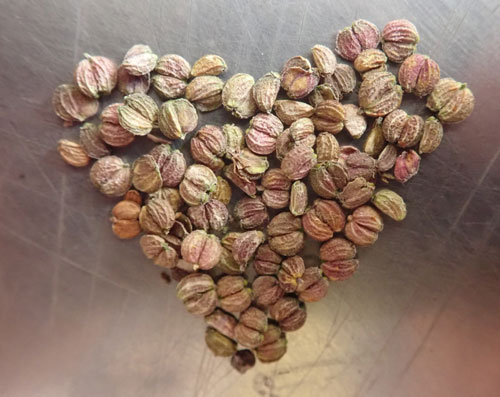
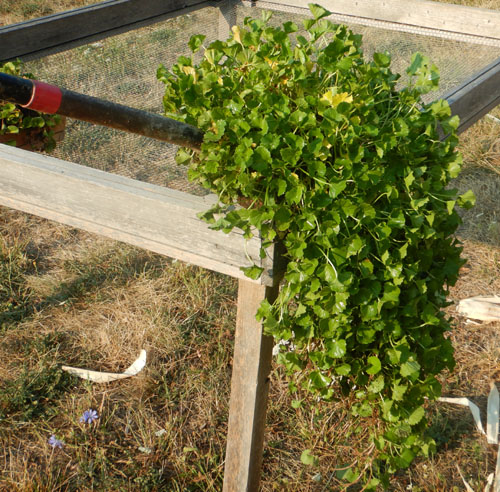
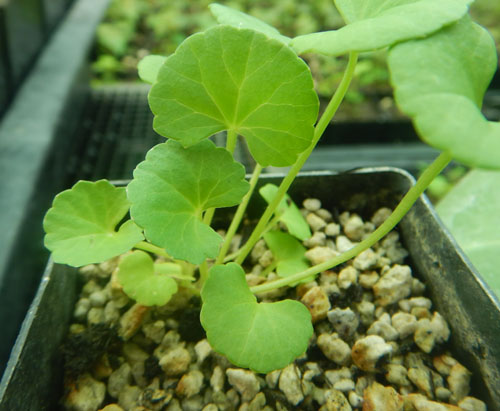
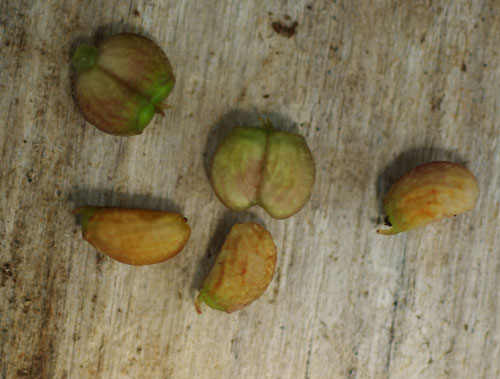
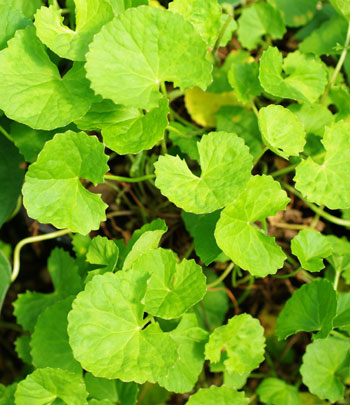
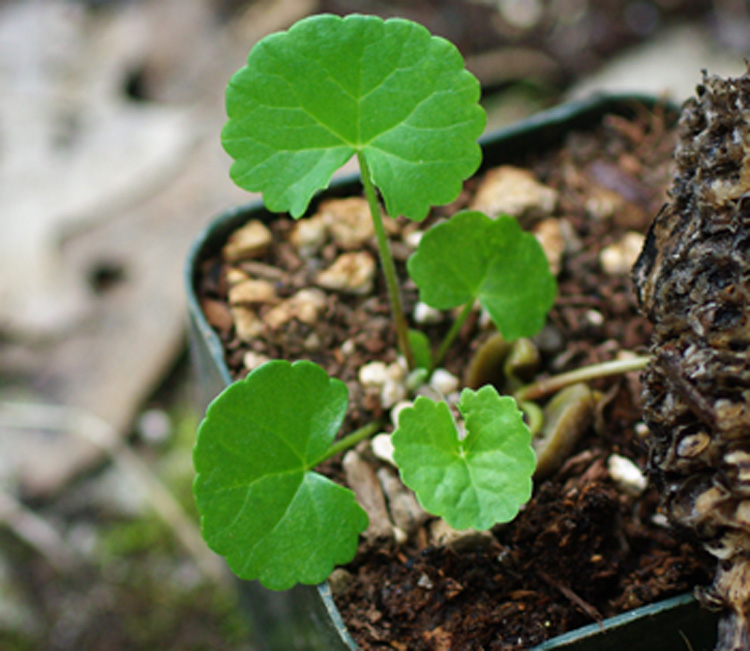

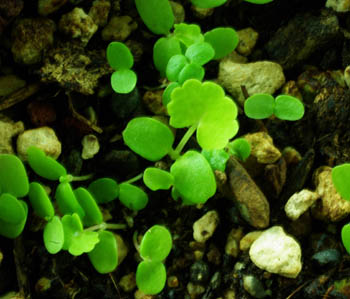
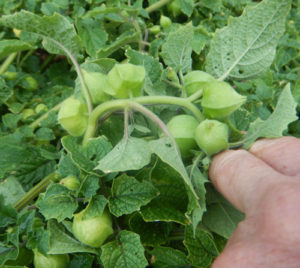
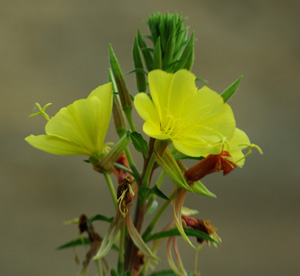
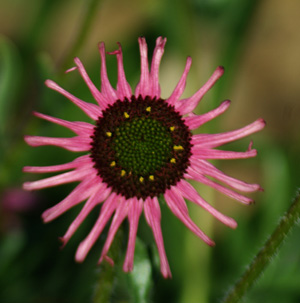
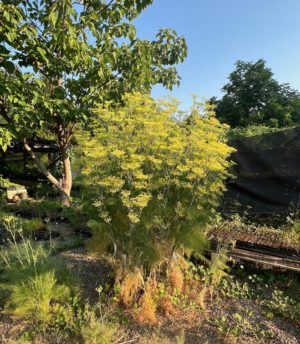
Rebecca (verified owner) –
I live in western Maine, zone 5. I purchased Gotu kola seeds from you in 2021. I was able to get 6 or 7 to germinate, planted them out, and had a wonderful success! I dug up a few of the ‘babies” in the fall, brought them inside for the winter and planted them back out the following spring. To my surprise around early July I started to see what looked like little baby gotu kola’s growing. These were sprouting right out of the ground, not runners, AND they were growing about 15 feet away from where I had transplanted my overwintered plants. That fall, I failed to dig up any “babies” in time to bring in for the winter. But sure enough, the next July I had little baby plants growing all around the area where the gotu kola had been growing the previous year. Fast forward to the next summer and I actually found a gotu kola growing about 75 feet away in a raised bed – no where near the original plants. My guess is these are just seeds that are overwintering and it takes until the heat of July for them to germinate here in Maine, BUT it’s great to know that I no longer have to sow seeds each year as I have had a bounty of gotu kola year over year from that original packet of seeds!!
Upvote if this was helpful (0) Downvote if this was not helpful (0) Watch Unwatch Flag for removal
Question
Marie Pagé (verified owner) –
Hi!
I have a question about gotu-kola and their germination. After 35 days, I managed to germinate 4 gotu-kula seeds from the 30 seeds. It’s now been 60 days and the gotu-kola sprout seem to have stopped growing 2 weeks ago. I planted them in a potting mix of half black earth and half fine sand, they are at 24-28 degrees Celsius. I placed them 15 inches below a growlight and I watered them once with a mixture of algae last week. I water them once a day, making sure the soil has time to dry.
Everything seemed to be going well, until it seemed to stop growing. Even the last sprout seems to have stopped compared to the others that sprout before.
I tried transplanting 2 of the 4 sprouts into potting soil with potting soil + volcanic rock (2/3) and vermicompost (1/3). I’m not sure if that was the right thing to do.
Do you have any advice?
Thanks,
Marie Pagé
Upvote if this was helpful (1) Downvote if this was not helpful (0) Watch Unwatch Flag for removal
Richo Cech –
hello Marie, Thanks for the detailed description. You have good plant propagation skills and are honing in on the right techniques. Low germ rate like that is an indicator that planting conditions are not quite right. Lay the seed on surface of potting soil and cover with 1/4 inch sifted pumice. For potting on, I do think the volcanic rock and vermicompost approach is a good idea. Gotu kola is persnickity in pots and will tend to fade after some time. We have entire flats that look great in February and go away by May. I prefer to use pots for short term grow-on, as an intermediary to getting them planted to the field, at which point they tend to do much better. They do not seem to appreciate constriction and larger pots (gallon or larger) sometimes rehabilitate slow-growing seedlings and produce lots of greenery. People think this is a water plant, yet I find excessive water makes them ill. Good drainage is a must. Plants that fail under grow lights often prosper in the sun. Read the Gotu Kola monograph in “Growing Plant Medicine Vol 1” for more exacting info.
Upvote if this was helpful (2) Downvote if this was not helpful (0) Flag for removal
LILA MCCLELLAN (verified owner) –
re: growing conditions, does gota kola like hot intense sun and heat or cooler climates and part shade?
Upvote if this was helpful (0) Downvote if this was not helpful (0) Watch Unwatch Flag for removal
Richo Cech –
hi lila, thanks for writing. gotu kola likes full sun and a moist, nutrient-dense soil. it can be grown in the summer garden much as you would a cucumber. richo
Upvote if this was helpful (2) Downvote if this was not helpful (0) Flag for removal
Question
pyroinsanity13 –
Hello,
Can gotu kola seeds be direct sown in zone 7a and produce new seeds before the frost gets them? We get at least 5 months of no frost per year.
I have the same question about Bacopa monnieri?
Thanks
Upvote if this was helpful (0) Downvote if this was not helpful (0) Watch Unwatch Flag for removal
Richo Cech –
Hi Pyro,
Thanks for getting in touch. In both cases the seeds are very challenging to get started and I personally would have a hard time direct-seeding them, I really rely on controlled conditions for these. Regarding maturation from seed to seed in 5 months, I don’t think that would happen. It would be reasonable to plant the plants in the spring garden in a Z 7 and get a good harvest of aerial parts, but seeds take longer with both species. richo
Upvote if this was helpful (1) Downvote if this was not helpful (0) Flag for removal
morph.brick –
A fast-draining soil and regular watering is a hassle. Does hydroponics work for pennywort? Any good suggestions for easier cultivation management will be appreciated.
Upvote if this was helpful (0) Downvote if this was not helpful (0) Watch Unwatch Flag for removal
Richo Cech –
hi morph, not sure about hydroponics and gotu kola. definitely worth a try. richo
Upvote if this was helpful (0) Downvote if this was not helpful (0) Flag for removal
Julie (verified owner) –
I’m a Vermont gardener (zone 5) and love growing Gotu Kola. I started the seed 2 years ago and have been growing it as a beautiful houseplant. It was outgrowing its pot, so this spring I decided to move it outside for the summer. I tucked it into the edge of a raised bed and with the rainy summer we’ve had, it took off. I’ll bring it back indoors for the winter and suspect I’ll have many babies to give away.
Upvote if this was helpful (2) Downvote if this was not helpful (0) Watch Unwatch Flag for removal
Richo Cech –
yup, this is the way to do it!
Upvote if this was helpful (1) Downvote if this was not helpful (0) Flag for removal
Femmaeve –
Omg! I’m in VT! Can I get some gotu kola babies from you?
Upvote if this was helpful (1) Downvote if this was not helpful (0) Flag for removal
Richo Cech –
We have some options for you. Growers in vermont can grow gotu kola outdoors in the summer garden, so you can buy plants and we’ll ship them to you in the spring. Or you can plant the seeds–this year was really a good one on gotu kola. Or if you can’t wait for these things, there is still organic gotu kola dried herb left although I would hurry on that, it is selling out fast. richo
Upvote if this was helpful (0) Downvote if this was not helpful (0) Flag for removal
Jay Narayan –
I recently bought gout kola seeds (Centella Asiatica) the seeds that I received shows as hydrocotyl asiatica – is it the same?
Upvote if this was helpful (0) Downvote if this was not helpful (0) Flag for removal
Richo Cech –
Hello Jay, It is the same. Hydrocotyl = centella. Richo
Upvote if this was helpful (0) Downvote if this was not helpful (0) Flag for removal
Lagoon sister (verified owner) –
Hello! I am from South Korea (Jeju island to be exact lol) and I received my gotu kola seeds yesterday! (They arrived faster than I expected 🥲) it’s about 13 Degrees Celsius in the daytime (55 Degrees Fahrenheit) and it is my first time planting gotu kola so I am very excited and nervous 🥲 i just have to space out the seeds in the pot and wait for it to germinate right?
Upvote if this was helpful (1) Downvote if this was not helpful (0) Flag for removal
Richo Cech –
hi, that is a bit cool, put the pot in the sun during the day and water a bit more frequently to keep it from drying out. we had excellent gotu kola seeds this year, they will work. r
Upvote if this was helpful (1) Downvote if this was not helpful (0) Flag for removal
christopheburrell –
You said you can ship the plant? How much would that cost .. to Massachusetts? thx.
Upvote if this was helpful (0) Downvote if this was not helpful (0) Flag for removal
Richo Cech –
greetings! a bit confused since this comment is left on our seed offering. Seeds are available from new crop and ship free of charge if $10.00 worth of packets are ordered. Plants cost priority mail postage to ship–you can review costs before finalization–the charges will depend on number of plants ordered. r
Upvote if this was helpful (0) Downvote if this was not helpful (0) Flag for removal
Question
thenaekedgardener (verified owner) –
Hello Richo,
The Gotu Kola plants you sent me back in 2020 have been producing abundant flowers and seeds!! Most have already split into three distinct sections of two seeds making 6? seeds total per flower as it appears to me….. When should I harvest my seeds on these?? If they’ve split a month ago, should I harvest or wait until summers end in about two weeks; starting from the base of the plant working my way down the runners as days go by????
Thank you!
-naeked
Upvote if this was helpful (0) Downvote if this was not helpful (0) Watch Unwatch Flag for removal
Richo Cech –
gotu kola surprisingly is in the carrot family (Apiaceae) and so seeds are paired. anything that is red or reddish-coloered is still in flower–leave it. seed harvest is picky–seeds at very base of plant, right at or in the soil, are usually best– if they’ve split into singles they are very much ready. Runners will have less mature seed. Old runners may have mature seed. dry on screen, rub thoroughly and table-separate to purity.
Upvote if this was helpful (3) Downvote if this was not helpful (0) Flag for removal
Josh VandeWerfhorst (verified owner) –
What does it mean that Gotu Kola seeds are paired? Do I plant a seed from both packs together?
Upvote if this was helpful (0) Downvote if this was not helpful (0) Flag for removal
Richo Cech –
hi josh, another name for paired seeds is syncarp. There are 2 seeds attached together. this is typical to the carrot family (apiaceae). a packet might contain 15 paired seeds = 30 seeds in all. Or it might have some that have broken apart. we are offering some really nice gotu kola seed these days. indeed i spent a few rather calm hours today table separating 3.8 grams of hard-won seeds, preparing them for packaging, looking at them under the microscope. . . r
Upvote if this was helpful (1) Downvote if this was not helpful (0) Flag for removal
Question
Janet L Kuenzi –
Last year I ordered gotu kola seeds on amazon because you were out. Got one seed to germinate and it has been quite vigorous, but now seeing your pictures and pictures on various sites… am thinking my plant may be an imposter. Some of the google images do look like mine but most have the serrated edges which mine does not have. Difference also in the veining and the depth of the notch in the heart shape. Post on Daves Garden pointed to much confusion in ID-ing it. My biologist son is unable to solve the mystery, but thought the leaves might acquire the serrated edge as they got older. So far it has only been in pots. I am concerned as I have sold some plant divisions at local farmer’s market. One clue would be if you could describe the taste of the leaf. I find it very aromatic almost incense-like or possibly like some exotic flower. I will send a picture when I can get someone to help me with sending it.(my computer skills are very minimal). Thank you I appreciate your consideration to this query….Janet Kuenzi
Upvote if this was helpful (0) Downvote if this was not helpful (0) Watch Unwatch Flag for removal
Richo Cech –
Hi Janet,
There is considerable variation in Hydrocotyl (Centella) asiatica depending on ecotype. There really are several different appearing plants that are indeed gotu kola. However what you have there doesn’t look like either of them–the leaves are too thick, too smooth, and as you mentioned lack the scallops. Gotu kola tastes like lettuce at its best and otherwise can be pretty bitter (out of prime season). The plant is enthusiastically stoloniferous so if your plant is sending out runners that root in at the nodes this might be a good sign. But there are other plants that do that. Lots of them. I wish nobody purchased seeds on e-bay, the majority of these sellers are buying seeds from reputable suppliers and reselling them without knowledge of identification or germination.
Richo
Upvote if this was helpful (1) Downvote if this was not helpful (0) Flag for removal
JOHNTHIIRU –
I would love some centella asiatica seeds for planting here in kenya my home. 😉
Upvote if this was helpful (1) Downvote if this was not helpful (0) Watch Unwatch Flag for removal
Admin Richo Cech –
You can order them online at strictlymedicinalseeds.com. I may be talking myself out of an order here, but in my experience in the highlands of kenya, gotu kola grows in great abundance. you would need to know how to recognize it. Inapatikana bwana, ukitafuta utapata! Riko
Upvote if this was helpful (1) Downvote if this was not helpful (1) Flag for removal
tea4234 –
when will these seeds be available?
Upvote if this was helpful (0) Downvote if this was not helpful (0) Flag for removal
Richo Cech –
Hi there! Gotu Kola seed harvest is around September to October. Hit “waitlist.”
Richo
Upvote if this was helpful (0) Downvote if this was not helpful (0) Flag for removal